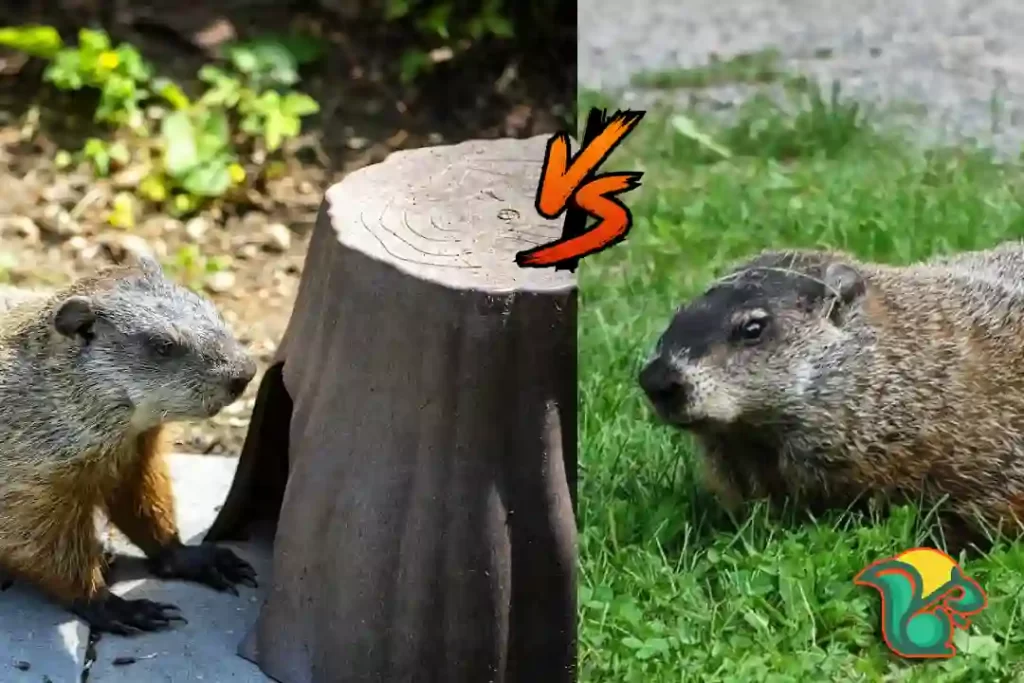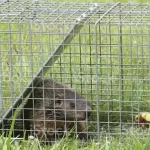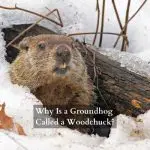Are Groundhogs and Woodchucks the Same?
The groundhog is a famous rodent. Are Groundhogs and Woodchucks the Same likely something that has crossed your mind at some point?
It seems to reason that these creatures must be distinct from one another because of the vast differences in their names. But the groundhog and the woodchuck are the same kinds of mammals. These creatures may be found all over the world, not only in North America, and their names vary according to where they are found.
Groundhogs live underground, so woodchuck must live in the wood-isn’t it? Or woodchucks surely eat tree bark but do groundhogs eat the soil? Well, well, well- you are not the only one who’s confused between groundhogs and woodchucks!
They are similar in looks. But then how do you tell the difference! Or is there any difference between them? Are groundhogs and woodchucks the same? What are their features and their family? Let’s say- it’s your right to know!

Groundhogs vs. Woodchucks
We are here to see the battle between groundhogs and woodchucks. Who’s more powerful? Whose family is better and how do they do their living? What is the difference between a groundhog and a woodchuck as they look the same? Let’s have a look!
The Difference
Groundhogs are mammals and this belongs to the squirrel family. The scientific name of this animal is Marmota Monax. But if you ask about woodchucks, we have to tell you that both are the same. They are from the same rodent-family species.
And not only is that, but the scientific name of both animals is also the same! Woodchucks also are look-alikes of squirrels. These fall under the identical category of the groundhog family.
Do you know why is a groundhog called a woodchuck? The name Woodchuck came from WUCHAK or WOOCHACK by the Algonquin tribe. But later, this was named WOODCHUCK by the English people.
The Diet
So, now that you know that groundhogs and woodchucks are the same, let’s discuss what they eat! Woodchuck eats crops of your field, that’s something you already know. Along with the crops, fruits are the favorite of these animals.
They also eat grass. If you ever see ruins in your yard, have a closer look and you will find groundhogs there. Don’t forget to get rid of them soon; otherwise, the lawn will be damaged!
In their diet, a very important thing is tree bark. Yes, they eat tree bark! Check out how much wood could a woodchuck chuck and keep them away from your yard my friend. In North America, you can easily find groundhogs or woodchucks. Along with that, Canada, Alaska, and United States are places where groundhogs are very common.
Home
By now, you already know where woodchucks live. They live under the ground. Mostly, they pick up a place where they find food and then dig up holes to make their little houses. Woodchucks or groundhogs live in burrows.
And within that, they can dig up more than 60 feet tunnels! All you can understand from this is they like to keep themselves safe from the outer world. For the work of digging, they use their thick claws. And for this reason, it is easy for them to dig burrow this long.
Along with this, another feature that benefits them is the strong limbs of these animals. They can dig burrow below your whole yard and you wouldn’t know anything about it- that’s why they say groundhogs are smart! To learn more, check out the Interesting Facts about Groundhogs– you will love to learn how they are!
Family
Marmots, like groundhogs, belong to the family of bigger land squirrels (Order Rodentia; Family Sciuridae; Genus Marmota). What do groundhogs look like, and how do they vary from squirrels?

The top incisor teeth of groundhogs are the most distinguishing characteristic of their mouths. This trait is what permits them to eat all their hard work in the garden.
They have a similar brownish-gray coloration to squirrels, although groundhogs are much larger and stockier (body: 16-20 inches long). In fact, groundhogs have short, black tails whereas squirrels have long, prominent tails (tail: 4-7 inches long).
Woodchucks/groundhogs, along with the other 14 species of marmot, are related to squirrel and prairie dogs. The Sciuridae family includes a wide variety of ground and tree rodents, including these creatures.
These creatures are related to one another, therefore they all share some traits. In addition to being able to hibernate and burrow, these pests may wreak havoc on your crops while foraging for food.
Hibernation
As Groundhogs and Woodchucks are the same- their manner of living in the same too! In the summer, they get out and collect food from outside and get them inside their burrows. But things are not the same when winter comes.
In the winter, like so many other animals, they hibernate. This is to keep them safe and warm during this season. But before the hibernation period, they prepare for hibernation. They keep working on the preparation for the whole summer and fall.
The hibernation season for the woodchucks starts in October and runs till March. And in this period, they hibernate in their burrows underground.
Hibernation and Reserved Fat
Well, yes, groundhogs eat a lot. But if you are seeing a lot of crops being damaged for the groundhogs, understand that they are not eating and wasting all the fat. Instead, they are preparing for the hibernation season.
Get your eyes on the best woodchuck bait for trap if you want to catch them and save your crops and plants! For their food, both for the other seasons and the winter, they like veggies along with fruits.
Also, as we have mentioned above, tree barks and grasses are their favorite. Among the vegetables, they love peas and beans, carrots, and grass. They eat these and keep the fat reserved so that they don’t need to get out of their burrows in winter.
Reputation
In popular culture, groundhogs are held responsible for foretelling the arrival of spring. Although celebrations of Groundhog Day have been going on for centuries, there is no actual proof that groundhogs can predict the weather.

European German settlers in Pennsylvania in the 1700s brought with them a tale (then known as Candlemas Day) with roots in Europe. According to folklore, six more weeks of winter lie ahead if the groundhog spots his shadow (when the sky is blue), while an early spring is predicted when the groundhog does not see his shadow (when the sky is overcast).
The majority of groundhogs have already seen their shadows. Some investigations show that the groundhog has only been right about the weather 40% of the time, yet the practice persists anyway. On February 2, people all around the globe watch groundhogs and woodchucks in an effort to forecast the weather for the next week.
Heart Rate
While talking about their hibernation, we must talk a bit about their heart rate in this period. It usually drops significantly in this season. From 75% to only 4 beats every minute-this is how the heart rate of the groundhogs drops when they are in the hibernating period. But for them, temporary peace and safety are necessary.

Lifespan
In the wild, groundhogs may live anywhere from three to six years. The average lifetime is three years. On the other hand, the lifetime of a groundhog that is maintained in captivity is typically three times longer than that of a groundhog that lives in the wild.

When living in the wild, a groundhog is susceptible to being devoured by bigger carnivores including wolves, bears, coyotes, eagles, and even snakes. The groundhog will sound a warning whistle when it becomes concerned, both for its own safety and the safety of any other groundhogs that may be nearby.
Due to the prevalence of this activity, the groundhog has been given the nickname “whistle pig”.
Germs, on the other hand, are not something that concerns groundhogs in the least. Groundhogs have carefree lives since they do not have to worry about being eliminated by contagious diseases because of their reputation for cleanliness and resilience to the diseases that infect and kill many wild animals.
Groundhog’s Day
Common people say that groundhogs are capable of predicting spring even before it arrives. And for this, February 2 is celebrated as Groundhog Day. It has been celebrated for hundreds of years now. But if you talk about the scientific evidence for this concept, you won’t find any.
You can complain about why this is named Groundhog Day and not a Woodchuck Day- we have no answer for it! Apologies, my friends! This day was called Candlemas Day for Europe and later, it was brought to America.
According to some people, if a groundhog can see a clear sky in the winter season, there will be six more winters. On the contrary, if the sky is cloudy, spring is soon to come! But these all are just ideas of common people and have not yet been proven. In some specific areas, the locals celebrate weather prediction activities bringing woodchucks.
Why is a Groundhog Called a Woodchuck?
Groundhogs got their common name, woodchuck, from the name that native Americans gave to this peculiar critter. The Algonquin people referred to groundhogs as “wuchak,”.

It is quite possible that the English immigrants who were residing in North America at that time adopted this term. The other term for groundhogs is “woodchucks,” yet these animals do not really chuck wood, but neither do they spend their days eating wood.
Frequently Asked Questions
1. Which Is Bigger a Groundhog or a Woodchuck?
In contrast to gophers, which have unique cheek pouches, groundhogs are larger, stockier rodents that sleep through the winter. Additionally, groundhogs hibernate. A groundhog is simply known by the name “woodchuck.”
2. Is Groundhog Another Name for a Woodchuck?
The word “woodchuck” does not refer to anything having to do with wood. The name “whistle-pig” comes from the fact that groundhogs often whistle in short, high-pitched bursts. Although they go by a few other names, “woodchuck” is by far the most common one.
3. Are Woodchucks Aggressive?
When they enter your property, groundhogs, which are sometimes referred to as woodchucks, are vicious creatures that are difficult to get rid of. These rodents will often do a great deal of damage by excavating tunnels in grasslands and eating their way through plants.
4. Should I Get Rid of the Groundhog in My Yard?
To address your question in a nutshell: yes, you really should. When they enter your property, groundhogs, which are sometimes referred to as woodchucks, are ferocious creatures that are difficult to get rid of. These rodents will often do a great deal of damage by excavating tunnels in the grass and eating their way through plants.
Wrap Up
The answer to the question “Are Groundhogs and Woodchucks the same?” is at hand. The only real distinction between a groundhog and a woodchuck is the latter’s longer nickname. The Algonquian word “wuchuck” was ultimately the inspiration for the English word “woodchuck.”
In short, an easy method of telling you the difference between groundhogs and woodchucks is nothing. There are no basic differences between these two rodent species. They are the same, just like your first name and the last. Their family, home, diet, hibernation, and manner of living are the same! But according to places, the names are different; that’s all




